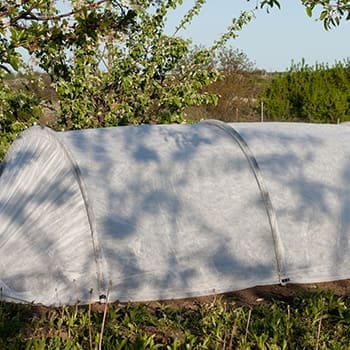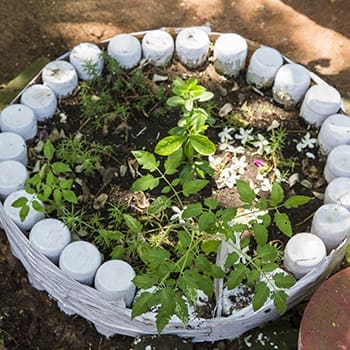When you live in a cold or temperate climate, you often must protect your plants from early fall or late spring frosts. Here are several quick and easy do-it-yourself projects that will cost little to no money.
Your chosen method will depend on your plants, their size, and the materials you have on hand. The best frost protection methods are those that reach down to ground level and cover the top of the plant to trap the most heat.
Group Your Potted Plants
Ideally, bring potted plants indoors into a cool room overnight, never next to a heat source, and move them back out the next day. If that isn’t possible, push your pots together for group protection in a protected corner or against a building to protect them from the wind.
You can also wrap the pots in blankets and cover the tops with a tarp, plastic, or a light blanket; just be careful not to smother young plants under something too heavy, and be sure to remove the covers during the day. If possible, potted plants should also be watered first since water moderates temperatures and protects them from cold winds.
However, never water if it is already freezing, or you will damage their roots.
Leaf, Pine Needle, or Straw Mulch
Mulch is a fantastic way to protect plants from frost. You can save dead fall leaves, collect pine needles, or use purchased straw. Spread the mulch over the root zone to protect their roots.
You can even gently bury smaller plants in mulch if it’s nice, light, and airy so you don’t smother them. When putting mulch on top of plants, ensure you never leave it on top for more than three days in a row. If you have a longer cold snap, remove it during the day and reapply at night so your plant can still photosynthesize when needed.
DIY Frost Tents
For larger plants, you don’t need to purchase frost tents or blankets when you can make your own using materials you have lying around. One method is to use plant stakes or poles that are just taller than your plants when inserted in the ground.
Place 3 – 4 stakes or poles around the plant a little ways away from it, but not too far; it depends on how bushy your plants are. Then, drape something over top of it, letting it hang over the poles and down to the ground.
You can use frost-cover blankets, tarps, clear plastic sheeting, bedroom sheets, blankets, car covers, garbage bags, bubble wrap, or burlap. People often wrap plants in blankets without making a tent with poles, but that may seriously damage the leaves and branches.
Also, the best frost protection occurs when your cover goes down to the soil level. Even if the soil is cold, it will always be warmer than the nighttime air, so when your cover goes down to the soil, it will trap any heat radiating upwards from the soil under the cover and protect your plant.
For plants under 2 feet tall, a tomato cage covered with a garbage bag works great and can be easily set up in under two minutes. Save the bags and re-use them for garbage, or keep them ready for your next frost.
It’s important to take frost covers off during the day if it starts to warm up. Plastic covers especially can damage your plants because it will heat them up too much, and the sudden temperature change can sometimes do more damage than just leaving them out in the frost and hoping for the best.
Homemade Hot Caps
Hot caps are like the cloches or mini-greenhouses you may have seen before. However, instead of buying those expensive clothes, make your own out of 2L plastic soda bottles or larger water jugs with intact lids. Simply cut the entire bottom off the bottle so you can put it directly over the plant. Be sure to leave the lids on at night to keep the heat in. If the lid is missing, wrap a piece of plastic on top, securing it with an elastic band. This is convenient because you can leave the bottles on during the day if you remove the lids to allow excess heat to escape.
If you don’t have plastic bottles, other quick substitutes include large bowls, cardboard boxes, buckets, plant pots (put something over the drainage holes to keep the heat in), and food serving covers. These items should all be removed the next day when it starts to warm up since there are no ventilation holes and no light can get through. You can even throw a tarp over the top for extra protection if it’s really cold.
Hot Water Bottles
Another method of using old plastic bottles is using them as hot water bottles. Fill them with hot water at night, no more than about ¾ full, so they don’t break when the water freezes and expands.
Alternatively, leave them in the sun during the day; you can even paint them black so they warm up even more. Then place them around your plants at night, under a frosted tent preferably, but even without a tent if the frost is not too severe. Then, the heat will dissipate into the air directly around the plants.
When it gets really cold, and the water freezes, this releases heat into the environment, so don’t worry if they freeze. However, be sure to warm them up the next day if you expect another frosty night.
Old Christmas Lights
If it’s really cold, you can use those old incandescent-style Christmas lights. Wrap them around your tender trees, then place a frosted tent over them. Those old lights put off a fair amount of heat that will be trapped under the frost tent.
Be sure to use a quality outdoor extension cord to handle the weather and the energy demand since incandescent lights can draw a lot of power. If you use indoor or poor-quality outdoor cords and overload the cord, you could risk a fire or lose power and wake up to frozen plants!
LED lights are not a great substitute since they put out little heat. However, if that’s all you have, choose your highest wattage, plug them in for an hour, and feel them. If they have any warmth, it will help, particularly if they are placed under a frosted tent.
You may also like:
Vegetables You Can Grow In Your Attic
How to Make the Ultimate Survival Food (Video)
Livestock In Winter: Mistakes Even The Most Advanced Homesteaders Make
25 Things We Did as Kids That Would Get Someone Arrested Today










